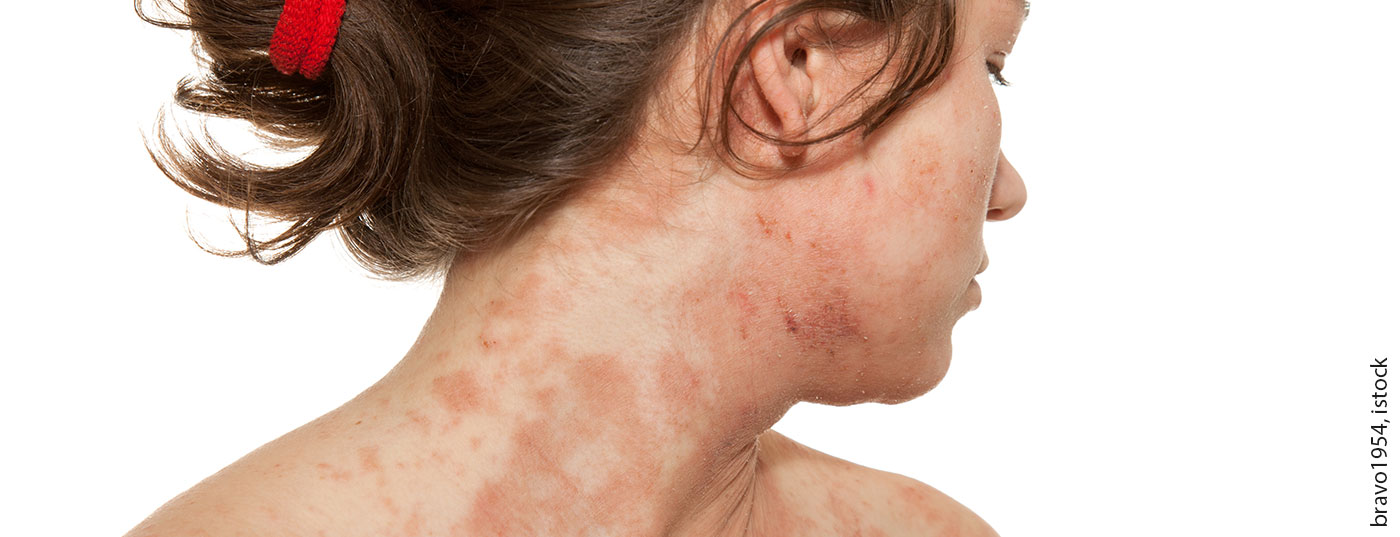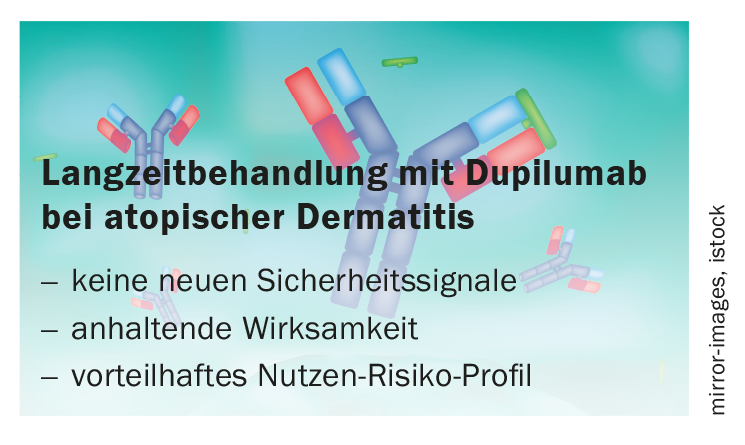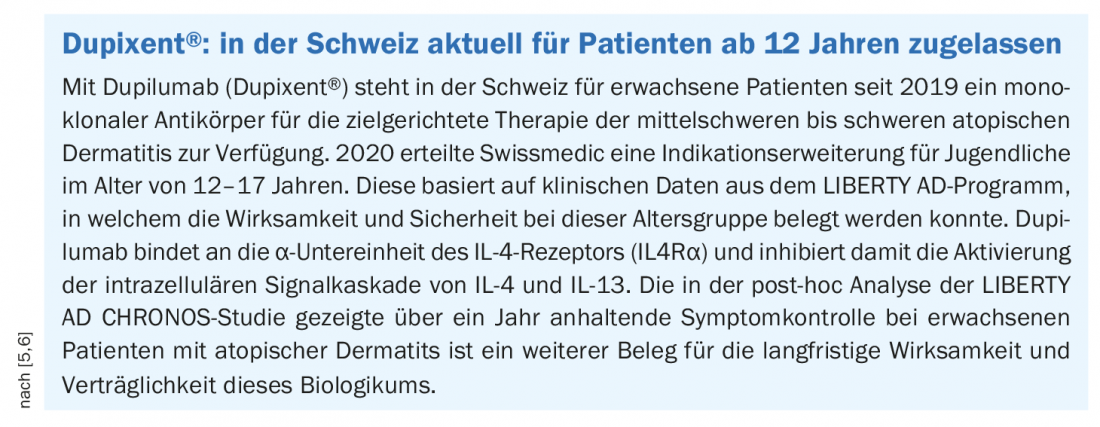In atopic dermatitis, long-term symptom control is one of the overriding therapeutic goals. A recently published post-hoc analysis demonstrated that patients treated with dupilumab achieved sustained and consistent improvement in symptoms and an increase in quality of life over the 1-year treatment period.
The pathogenesis of atopic dermatitis is characterized by a Th2-mediated immune response dominated by cytokines such as interleukin(IL)-4 and IL-13, causing an inflammatory response and epidermal barrier dysfunction [1]. The expression of IL-4 and IL-13 correlates with disease activity [2]. In addition to inflammatory lesions, excruciating pruritus is one of the leading symptoms of this chronic recurrent dermatosis. The therapeutic effect of dupilumab (Dupixent®) in atopic dermatitis was demonstrated in a phase III study in 2017 [3]. After 16 weeks of treatment (300 mg dupilumab, subcutaneously, at weekly or biweekly intervals), there was significant relief of itching, skin lesions, and skin infection rate with corresponding improvement in quality of life. Long-term studies support the safe side effect profile, which is very beneficial for long-term treatment [4,5].
LIBERTY AD CHRONOS Study
The double-blind, randomized-controlled LIBERTY AD CHRONOS study evaluated the treatment effects of dupilumab (s.c.) in combination with topical glucocorticoids (TCS) over the course of one year compared with placebo [4,6]. In this parallel-group design study, 740 adult patients with moderate to severe atopic dermatitis were randomized to the following trial arms: Dupilumab (300 mg, weekly) + TCS; Dupilumab (300 mg, every 2 weeks) + TCS; Placebo + TCS. At week 52, a significantly greater proportion of the dupilumab groups met the primary endpoint of complete/nearly complete healing as measured by Investigator’s Global Assessment (IGA), 39%, compared with 12% in the placebo group [6]. A 75% reduction in EASI (Eczema Area and Severity Index) was achieved at 16 weeks in 64% and 69%, respectively, in both dupilumab groups and in 23% in the placebo group; these values remained constant over the 52-week study period. No laboratory abnormalities were documented throughout the treatment period; local reactions at the injection site and conjunctivitis (14% and 19% in the dupilumab groups versus 8% in the placebo group) were the most common adverse events [4].
Results of the post-hoc analysis
To examine long-term symptom control with dupilumab therapy, a post-hoc analysis of the LIBERTY AD CHRONOS trial was conducted [4,7]. This determined the proportion of study participants treated with 300 mg q2w* dupilumab+TCS who achieved significant improvement in various endpoints over the 1-year treatment period compared with placebo+TCS. There were 10 measurement time points from week 16 to 52, each at four-week intervals. Across all these follow-up measurements, the dupilumab q2w* + TCS group (n=106) showed consistent symptom improvement in a higher proportion compared to placebo+TCS (n=315). EASI-50 was achieved by 70.8% with dupilumab and 19.7% with placebo. Regarding EASI-75, the corresponding values were 48.1% vs. 8.6%. As expected, the quality of life assessed by DLQI (Dermatology Life Quality Index) was also clearly superior to the placebo condition. Thus, 64.2% in the dupilumab study arm achieved an improvement in the DLQI by at least 4 points; in the placebo group, this proportion was 18.4%. As another patient-reported outcome, scores on the POEM (“Patient-Oriented Eczema Measure”) were measured: an improvement of 4 points was observed in 62.3% of patients treated with dupilumab+TCS compared with 13.0% in the placebo+TCS-treated group. Last but not least, in the weekly peak pruritus NRS score, a reduction of at least 3 points was documented in 65.1% of patients treated with dupilumab + TCS in at least six follow-up measurements, whereas this rate was 17.1% under placebo+TCS.
* every 2 weeks = q2w
Literature:
- Quint T, Bangert C: Biologics therapy of atopic dermatitis. close up 2021; 20: 37-44.
- Gooderham MJ, et al: Dupilumab: A review of its use in the treatment of atopic dermatitis. J Am Acad Dermatol 2018; 78(3, Suppl 1): S28-36.
- Simpson EL, Akinlade B, Ardeleanu M: Two Phase 3 Trials of Dupilumab versus Placebo in Atopic Dermatitis. N Engl J Med 2017; 376(11): 1090-1091.
- Blauvelt A, et al: Long-term management of moderate-to-severe atopic dermatitis with dupilumab and concomitant topical corticosteroids (LIBERTY AD CHRONOS): a 1-year, randomised, double-blinded, placebo-controlled, phase 3 trial. Lancet 2017; 389: 2287-2303.
- Deleuran M, et al: Dupilumab shows long-term safety and efficacy in patients with moderate to severe atopic dermatitis enrolled in a phase 3 open-label extension study. J Am Acad Dermatol 2020;82(2): 377-388.
- S2k Guideline Neurodermatitis, Update System Therapy, 2021, www.awmf.org/fileadmin/user_upload/Leitlinien/013_D_Dermatologische_Ges/013-027l_S2k_Neurodermitis_Aktualisierung-Systemtherapie_2021-05.pdf, (last accessed Jan. 18, 2022).
- Blauvelt A, et al: Consistency of Response to Dupilumab in Adults with Moderate-to-Severe Atopic Dermatitis Over 1 Year. Dermatol Ther (Heidelb) 2022, https://doi.org/10.1007/s13555-021-00657-y, (last accessed Jan 18, 2022).
- Drug Information, www.swissmedicinfo.ch (last accessed Jan. 18, 2022).
- D’Ippolito D, Pisano M: Dupilumab (Dupixent): an interleukin-4 receptor antagonist for atopic dermatitis. Pharmacy & Therapeutics 2018; 43: 532-535
- Simpson EL: Efficacy and Safety of Dupilumab in Adolescents With Uncontrolled Moderate to Severe Atopic Dermatitis: A Phase 3 Randomized Clinical Trial. JAMA Dermatol 2020; 156(1): 44-56.
DERMATOLOGY PRACTICE 2022; 32(1): 33














